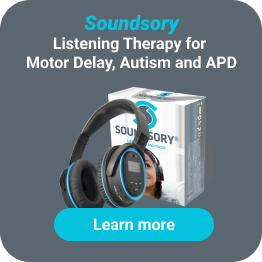Primitive Reflex Integration: A Comprehensive Guide for Parents and Practitioners from an OT expert
 Rachel Ann Melegrito
Rachel Ann Melegrito Occupational Therapist
April 19, 2024

OT expert: Kara Tavolacci, SIPT Certified Occupational Therapist
Kara Tavolacci, a US-born pediatric occupational therapist, holds degrees in Psychology (1999) and Occupational Therapy (2004). Specializing in pediatrics, she’s certified in various therapeutic approaches, offering comprehensive evaluations in English and French.
Introduction
If you’ve ever held a baby, you might have noticed those cute little movements they make. You might even think they’re starting to move a bit early! But actually, those movements are reflexes — totally automatic and beyond their control. As the baby’s brain develops, these reflexes gradually fade or “integrate” into the voluntary movements we see as they grow. But things go wrong when these reflexes don’t disappear. They interfere with learning and skill development, impacting your child’s independence — from performing basic movements like crawling, to doing more skilled activities like handwriting.
In this article, we’ll explore everything about primitive reflexes. We’ll discuss what they are and the impact of their retention on skill development. We’ll also guide you on checking for retained reflexes and share some strategies that can help manage them.
Our expert, pediatric OT Kara Tavolacci, OTR/L, SIPT certified, breaks down this critical aspect of early development, offering insights for parents and practitioners alike.
This piece draws on insights from a recent webinar.
Key Take-Away Messages
| What is Primitive Reflex Integration? |
| Primitive reflex integration is the expected and timely disappearance of primitive reflexes, typically occurring 4 to 6 months after birth. It may also refer to specialty interventions or methods that aim to address retained reflexes and promote their integration. |
Try Soundsory®, a unique blend of music and movement therapy, to enhance your child’s neurodevelopment.
What are Primitive Reflexes?
Primitive reflexes are involuntary motor responses present at birth. These reflexes originate from the brainstem and are necessary for the infant’s survival [1]. For instance, some of these ensure that the newborn can locate and suck from their mother’s nipples, while another ensures proper breathing and swallowing [2]. Other reflexes protect them from potential injuries, while others lay the foundation for voluntary movement as the infant’s brain matures.
Medical practitioners assess the integrity of a newborn and young infant’s central nervous system (CNS) by examining their reflexes. These reflexes appear and disappear at specific times during early development [3]. Typically, they vanish by 4 to 6 months of age. However, if they are absent, reappear later, or persist beyond this age, it may indicate a neurological problem [1].
The 7 Most Common Primitive Reflexes
Below are the most common primitive reflexes present at birth, how they look like, and what stimulus initiates them. Each section also details when they are expected to emerge and become inhibited.
Moro Reflex
- Emergence: 9 weeks in utero
- Activity during birth: Fully present
- Integration: 2 to 4 months
Compared to the tight, cozy confines of the womb, a newborn is bombarded with many new sensations that they can’t yet process. This reflex is part of a baby’s built-in survival mechanism – an involuntary response to potential threats. It alerts the infant and triggers the “fight or flight” response.
This reflex gets triggered by sudden changes in head position (vestibular), noise (auditory), and sudden movements or light changes within the newborn’s visual field (visual). Being handled too roughly, pain, and temperature changes (tactile) also trigger the reflex.
The typical response is a startled or frozen reaction where the baby inhales sharply, followed by an exhale, and usually a cry. Because this triggers the fight or flight response, accompanying this response is increased heart rate, blood pressure, and breathing. While it is expected to react to threats, the Moro reflex may still be present if everyday occurrences like lights turning on or music playing in the background startle them and trigger strong reactions.
Rooting reflex
- Emergence: 24-28 weeks in utero
- Activity during birth: Fully present
- Integration: 3 to 4 months
The rooting reflex occurs when the corner of a baby’s mouth or cheek is touched, prompting them to turn their head towards the touch with an open mouth and extended tongue, ready to suck. This reflex varies in strength — it’s weaker or disappears just after feeding and stronger when the baby is hungry.
Palmar reflex
- Emergence: 11 weeks in utero
- Activity during birth: Fully present
- Integration: 2 to 3 months
The palmar reflex is triggered by a light stroke or pressure on the palm. The infant responds by closing the hand and grasping. This reflex should disappear over time to allow for the development of more refined hand movements, such as pinching small objects between the thumb and index finger, which is necessary for self-feeding tasks like picking up cereal.
The action of sucking can also stimulate this reflex. The baby may turn the head toward a stimulus and open his mouth to suck, coupled with flexion of the forearm and kneading of hands in sync with the sucking movements [4]. This is called the Babkin response. This illustrates the early developmental connection between the mouth and hands. You can see this in older children; for instance, when a child is cutting with scissors, you might notice their mouth-puckering or opening and closing in response to the hand movements.
Spinal Galant
- Emergence: 20 weeks in utero
- Activity during birth: Fully present
- Integration: 3 to 4 months
To trigger the Galant reflex, place the baby on his belly and stroke one side of the spine. This will result in the baby’s hip flexing towards the stimulated side. This reflex is believed to be important during labor, as contractions stimulate the baby’s back, leading to small rotational movements of the hips toward the stimulated side, helping the baby navigate down the birth canal.
One study suggested that this reflex may be a sound conductor in the womb. It was also found that auditory training decreased this reflex, which persisted among children with developmental language disorder [5].
Tonic labyrinthine reflex
- Emergence: in utero
- Activity during birth: Fully present
- Integration: 4 months (forward); 3 years (backward)
The tonic labyrinthine reflex has two movement patterns: forward and backward. For this reflex, flexing the infant’s head causes the arms and legs to flex, while extending the head also extends the arms and legs. This reflex and the Moro reflex are said to be closely linked, with both being vestibular in origin. As the baby develops better head control during activities like tummy time, this reflex gradually becomes integrated.
Asymmetrical tonic neck reflex (ATNR)
- Emergence: 18 weeks in utero
- Activity during birth: Fully present
- Integration: 6 months
This reflex is known as the archer’s reflex because when a baby’s head is turned to one side, the arm on that side extends, and the opposite arm flexes, resembling an archer drawing a bow. This action helps increase the extensor tone on each side of the body.
Additionally, it sets the foundation for eye-hand coordination and future voluntary reaching movements. As babies develop, this reflex allows them to turn their heads toward an object and eventually reach out and grab it.
Symmetrical tonic neck reflex (STNR)
- Emergence: 6 to 9 months of life
- Integration: 9 to 11 months
The STNR reflex is triggered by moving the head while the baby is on all fours. When the head is flexed, this reflex causes the arms to bend and the legs to extend. Conversely, extending the head leads to the arms straightening and the legs bending. This reflex helps the baby move against gravity, so you’ll find this reflex getting inhibited during the child’s creeping and crawling stages. If retained, they might resort to bear walks, shuffle their bottoms, or even skip crawling entirely, pulling themselves up to walk.
As children crawl, they typically look ahead toward their destination and coordinate their movements to get there. This demonstrates how the STNR reflex is essential in training the ocular system and improving eye-hand coordination.
Testing for Retention
So, how do you know if your child has retained one or more of these reflexes? Here’s how you can test for the retention of each reflex:
Moro reflex: Have the child sit on a chair and ask them to fully open their arms and legs like a star. Then, have them bring their limbs back toward the center, crossing them over each other at the midline.
Rooting reflex: Stroke downward from the nose’s side to the mouth’s corner. Repeat and gradually move your finger outward with each stroke. Observe for any movement in the mouth on the side you are stroking.
Palmar reflex: Instruct the child to hold their palm up with their fingers spread apart. Stroke from the thenar crease, which is the crease closest to the thumb, toward the middle of the wrist. Observe whether the fingers attempt to close or if the elbow slightly bends.
Spinal Galant reflex: While the child is lying on their belly, gently stroke along the side of the spine, one side at a time. Observe for any signs of tightness, contraction, or jerky movements on the stimulated side.
Tonic labyrinthine reflex: While the child is on their belly, have them place their hands at their sides with their feet and legs extended flat. Then, ask them to lift their head, arms, and feet off the ground, keeping their body straight to form a concave shape. Observe if they can maintain this position with their arms and legs extended and without touching the ground.
Asymmetrical tonic neck (ATNR) reflex: Have the child stand and extend their arms straight in front of them. Ask them to keep their arms in this position while they turn their head to the left and right. Observe any movement in the arms, shoulders, or elbows as they move their head. You can also do this on all fours.
Symmetrical tonic neck (STNR)reflex: In the all-fours position, ask the child to tuck their head toward their chin slowly and then move their head upward towards their back. See if their arms or legs will bend or if their back arches or twitches.
Impact of Retention on Skills
While some reflexes ensure the newborn’s survival by triggering automatic movement, most other reflexes lay the groundwork for more mature reflexes, like righting, postural, and protective reactions [6]. Retention of reflexes significantly affects your child’s functioning as they hinder your child’s voluntary movements, preventing the progression of your child’s development.
Moro reflex
A child who retains this reflex may still react involuntarily to threats. They may be hypersensitive or avoidant to certain sensory stimuli, like light, movement, or sound. They might not enjoy changes or surprises. Because they’re always tense and in fight or flight mode, they might have mood swings or meltdowns or follow a cycle of hyperactivity followed by excessive fatigue.
Rooting reflex
When the rooting reflex hasn’t integrated, the child may present with hypersensitivity around the lips and mouth and their tongue may stay too far forward in the mouth, causing difficulty in managing solid foods. A child may still drool or have speech and articulation problems.
Palmar reflex
A persisting palmar reflex can lead to difficulties with manual dexterity by hindering independent movements of the thumb and fingers. As a result, a child might struggle to develop the pincer grip — essential for holding items between the fingers — which can affect tasks like pencil grip and handwriting. Additionally, the child’s palm may become hypersensitive because it remains closed frequently.
Interestingly, one study suggests that stimulating the palmar reflex can help inhibit the Moro reflex; this might explain why using stress balls or clenching one’s fists when tense can be calming [7].
Spinal Galant
A study suggested that children with persisting spinal galant tend to have poor bladder control or struggle with bedwetting even beyond the age of 5 [8]. Another study showed that a huge number of people with irritable bowel syndrome (IBS) still have this reflex. In the classroom, those with this reflex tend to squirm or wriggle their seats. This can be because the seats or their pants could trigger the reflex.
Tonic labyrinthine reflex
A persisting TLR may cause a range of vestibular problems like poor balance, posture, and gravitational insecurity. Since how your eyes work together is a vestibular system function, you may also have ocular-motor problems, like spatial relations and visual perception. It might also hinder a child from moving through the crawling phase because it influences your arms and legs.
Asymmetrical tonic neck reflex (ATNR)
The ATNR is key in helping distinguish the left and right sides of the body. If this reflex persists, it may hinder a child’s ability to perform activities that involve coordination of both sides, such as crawling, skipping, walking, and marching. It can also impact the ability to cross the midline. This delay can affect the establishment of hand dominance. As a result, actions that should be automatic, like handwriting, require more conscious effort and focus due to challenges with laterality.
Symmetrical tonic neck reflex (STNR)
Children with persisting STNR often slump in their seats and may exhibit difficulty coordinating eye and hand movements, resulting in clumsiness and messiness. They can also face challenges with tasks requiring binocular vision adjustments, such as shifting focus between the board and their desk.
Intervention Strategies
Fortunately, there are effective strategies to help children integrate retained reflexes, supporting their overall development. It’s crucial to understand that many developmental processes, such as hand skills, emotion and stress regulation, brain arousal, and memory, are interconnected with the auditory system. This connection explains why programs designed to stimulate the auditory system can be highly beneficial in integrating primary reflexes.
Soundsory ®
Soundsory ® is a program that targets the auditory and other systems, like the vestibular system. It uses a propriety listening device that stimulates the brain through both air and bone conduction. A dynamic filter alters the sound quality, engaging the brain and training the ear muscles to better manage auditory stimulation.
The program features a range of exercises that synchronize with Soundsory’s music collection, spanning genres such as Strauss/Waltz, Bach, Jazz, children’s songs, and more. These exercises come with primitive reflex integration exercises sprinkled throughout the program, along with other exercises aimed at improving foundational skills such as balance and posture. The exercises are structured into three levels to accommodate children at different stages of skill and ability.
Forbrain ®
Forbrain® is another innovative tool that leverages neuroplasticity — the brain’s ability to adapt and change. Designed to enhance communication and listening skills, Forbrain ® reprograms how the brain processes information. It utilizes a microphone to capture your voice and employs a dynamic filter to modulate its sound. This altered sound is then transmitted back to you through bone conduction. This method retrains the auditory system’s feedback loop, enhancing arousal, attention, memory, and other cognitive functions.
You can also use exercises from Soundsory® that can help integrate these primitive reflexes. You can incorporate it into your home exercises or treatment program if you’re a therapist. Examples include Open/Close, which targets retained Moro reflex, and Marching in place to address retained ATNR reflex in children. To access over 50 videos featuring body movement exercises and helpful tips, download the Soundsory App from the App Store or Google Play.
Conclusion
Reflexes serve as a newborn’s initial survival mechanism and play a significant role in a child’s early developmental stages. These primitive reflexes are crucial for immediate post-birth functions but should gradually integrate as a child grows. When these reflexes persist, they can hinder the development of more complex skills necessary for activities like feeding, handwriting, and reading.
It is essential for parents and therapists to recognize when these reflexes are retained and to seek ways to facilitate their integration. Tools like Soundsory® and Forbrain® utilize advanced techniques based on neuroplasticity to support and enhance this process. Soundsory’s music-based exercises and Forbrain’s feedback loop retraining offer innovative ways to improve cognitive functions and sensory integration.
References
1. Modrell A. & Tadi, P. (2023). Primitive reflexes. In: StatPearls [Internet]. Treasure Island (FL): StatPearls Publishing
2. Harjpal, P., Kovela, R. K., & Qureshi, M. I. (2023). Promoting Survival and Primitive Reflexes to Prevent Brain Imbalance in Premature Infants: A Scoping Review of New Insights by Physiotherapists on Developmental Disorders. Cureus, 15(8), e43757. https://doi.org/10.7759/cureus.43757
3. Beltre G. & Mendez MD. (2023). Child Development. In: StatPearls [Internet]. Treasure Island (FL): StatPearls Publishing
4. Futagi, Y., Yanagihara, K., Mogami, Y., Ikeda, T., & Suzuki, Y. (2013). The babkin reflex in infants: clinical significance and neural mechanism. Pediatric neurology, 49(3), 149–155. https://doi.org/10.1016/j.pediatrneurol.2013.04.005
5. Matuszkiewicz, M., & Gałkowski, T. (2021). Developmental language disorder and uninhibited primitive reflexes in young children. Journal of Speech, Language, and Hearing Research, 64(3), 935–948. https://doi.org/10.1044/2020_jslhr-19-00423
6. Arcilla CK, Vilella RC. Tonic Neck Reflex. (2023). In: StatPearls [Internet]. Treasure Island (FL): StatPearls Publishing
7. Futagi, Y., Toribe, Y., & Suzuki, Y. (2012). The grasp reflex and moro reflex in infants: hierarchy of primitive reflex responses. International journal of pediatrics, 2012, 191562. https://doi.org/10.1155/2012/1915628. Brown, M., Revels, B., & Smith, S. (2005). Correlative study of uninhibited primitive reflexes in adults with ADD/ADHD. Unpublished manuscript. Logan University



